From the October 2021 issue of Apollo. Preview and subscribe here.
When I think about it,’ Richard Estes says, ‘I realise I learned much more from working in advertising than I ever did at the Art Institute of Chicago.’ He has that in common with a number of artists of his generation who learned a great deal from their experiences outside formal art education: think of Andy Warhol’s years in commercial art, Richard Hamilton’s work during the war as an engineering draughtsman, or Patrick Caulfield’s stint in the advertising department of the food manufacturer Crosse & Blackwell. But whereas Warhol emerged from his years as an illustrator with a fascination for the aesthetic possibilities of commercial imagery and mass media, Estes came away with a new method of making a painting.
Initially Estes (b. 1932) was grouped together with contemporaries such as Ralph Goings (1928–2016), Robert Bechtle (1932–2020) and Charles Bell (1935–1995) under the umbrella term ‘Photorealism’. But as Edward Lucie-Smith has noted, ‘even those who decried Photorealism from the start tended to make an exception’ for the work of Estes. This was partly because of the sheer quality of his work, but also – as he explains to me over the telephone from his house in Maine – because Estes has a complicated relationship with photography but a straightforward one with the realist tradition in American and European painting. This autumn he has his first major solo exhibition in Britain at the Newport Street Gallery (10 September–12 December).
It was a job for Reader’s Digest that prompted one of his most celebrated early works: ‘They commissioned illustrations for a story and one of the scenes concerned someone calling another person on the telephone. So I went around taking pictures of people in telephone booths and I did one painting for them of just one figure in a telephone booth. Then later on I decided to use some of the photographs of a row of booths. In a way, I de-emphasised the figure.’
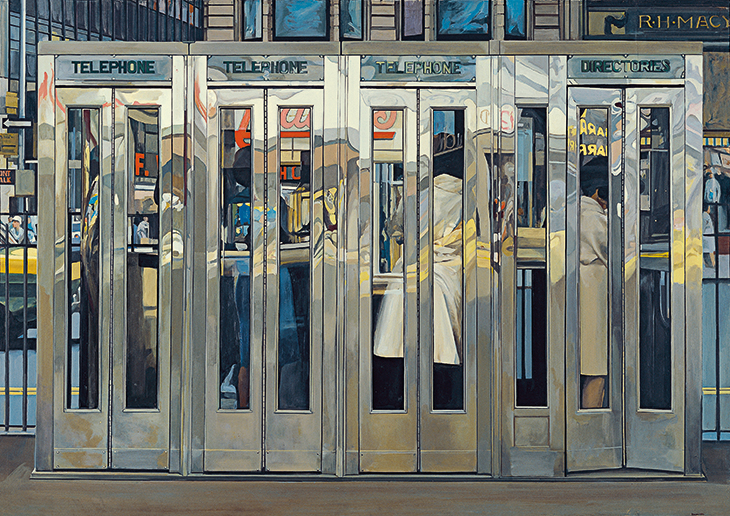
Telephone Booths (1967), Richard Estes. © Richard Estes
The result was Telephone Booths (1967). It is an image of New York as memorable in its own way as Edward Hopper’s Nighthawks or Early Sunday Morning. It seems to pin down some of the city’s most crucial characteristics: hi-tech modernity, bustle, anonymity… Although Estes has ‘de-emphasised the figure’, people are still there, occupying the booths, but they are sealed off from one another, detectable only as stray areas of overcoat or collar, merging into a powerful and acrobatic break-dance of reflections.
It is tempting to call this pulsing visual pattern of things, people and their distorted images a boogie-woogie, recalling Mondrian’s celebrated New York paintings, but bebop, bossa nova, or free jazz would be more fitting for the era in which it was made. Estes’s rhythms are also much more complex than Mondrian’s. There is a ground beat set up by the geometric grid structure of the booths themselves. But over this grid he places wild curves, whirls and zigzags created by reflections in the shiny but not quite flat casing of the booths. Meanwhile, and this is typical of Estes, there is a further interplay between the reflections on the glass doors of the booths, and what is visible through the glass. It is not always obvious which is which, although a strip of unmediated Manhattan can be seen at the sides and top, providing some clues.
Estes seems slightly surprised that this rhythmic virtuosity should even be worth mentioning. ‘Well, basically that’s what painting is. It’s something visual, to look at. A lot of political commentary and so forth on painting just misses the point of what it’s all about.’ Not just Telephone Booths, but nearly all of Estes’s urban images have the same formal, complex intricacy as much of the ’50s and ’60s abstract painting, whether colour field, ‘hard-edge’ or Op Art. Their geometry, for instance, has parallels in the work of Frank Stella, another near contemporary. But Estes has stated (in a conversation with Gregory Peterson) that for him abstraction is just a part of what he is doing: ‘You always have to have that quality, but it’s just one element of the painting. Pure abstraction is like having a lot of sound without any melody.’ Lucian Freud – another artist who might be termed ‘realist’ or ‘naturalist’ – said similar things about abstraction being a necessary ingredient in a work; Freud added, as a corollary, that a good abstract painting needs to contain ‘something of the world’.
Both the subject matter and what one might call the ‘emotional tone’ of Estes’s paintings are determined by his visual interests and everyday experiences. Of reflections, for example, he explains that New York in the 20th and 21st centuries just is full of reflective surfaces such as plate-glass windows and car bonnets of the kind that appear in such recent works as Express (2020; see p. 13) or Tour Bus (2012). In a similar spirit Edward Hopper, when it was pointed out to him that Early Sunday Morning has an intense, theatrical atmosphere, insisted that the painting was ‘almost a literal translation of Seventh Avenue’. Perhaps Vermeer would have said the same about View of Delft.
Estes has used photographs as a basis for his work since the 1960s. However, he has always emphasised that a photograph is only a partial record. He told the writer and art dealer Louis Meisel that he wouldn’t use someone else’s photograph of somewhere he didn’t know. He could copy such a snap, but he wouldn’t have a feeling or a memory for the place, and when painting ‘you’re always remembering’.
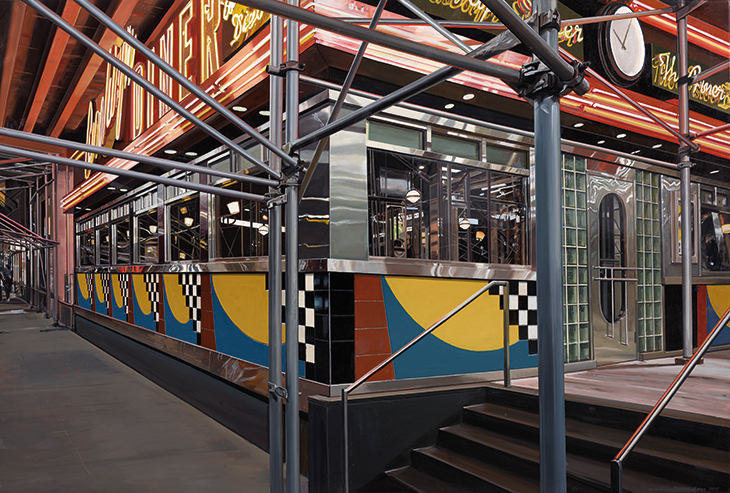
Brooklyn Diner (2021), Richard Estes. © Richard Estes
His work overlaps with Pop art, but by accident, because his focus on the modern city means that certain items such as the neon shop signs that can be seen in Brooklyn Diner (2021) just happen to be there. He suspects that it was the presence of such things that appealed to the ‘Pop art sensibility’ of dealers such as Allan Stone, at whose gallery he had his first solo exhibition in 1968. It sold out, and immediately Estes shifted from being a ‘commercial artist’ to being a full-time painter.
Although he has pointed out that he didn’t actually know any of the other ‘Photorealists’, he is philosophical about the label. ‘I have no control over what they are going to call me.’ The second half of these tags makes much more sense to him: ‘All I thought was that basically I wanted to paint realism not abstraction. It’s only photographic because it’s easier to do.’
Far from being a native New Yorker, Estes doesn’t even come from Norman Rockwell-style small-town America; he grew up in more of a village. He was born in the city of Kewanee, Illinois, because that was the local centre where the hospital was, and the Estes family lived in the village of Sheffield (population 926 at the last census) before moving to Evanston. When he was eight or nine he was given a painting set for Christmas. When time for further education came, he went to the Art Institute in the regional metropolis of Chicago. But even at this stage he assumed he would become a commercial artist or designer, rather than a full-time painter. That did not happen until he was well into his thirties. For a late starter, he has nonetheless had a very long career. At the age of 89 he is still busy at his easel: ‘I only do around ten paintings a year, I think. But I’m sort of loosening up a little these days, so maybe I’ll be able to speed it up a bit, I don’t know.’
To begin with his commercial work and the painting he did in his spare time were largely separate. ‘I started using photos because I was working in advertising, doing illustration. I didn’t do anything like that in art school. I worked quite differently for a decade after I left art school. Then I decided to change what I was doing, I was in a rut, painting a sort of semi-abstracted realism.’ As Estes went on, he slowly found his own idiom. At first, he would sketch in cafeterias or out in the street, until it struck him that this was pointless, even ‘masochistic’. It made what he was trying to do more difficult, but not necessarily any better. The moments that particularly interested him, such as passing reflections in a shop window, might last only a few seconds. Attempting to capture all this by sketching on a Manhattan sidewalk, with the wind blowing his equipment about and passersby asking silly questions, started to seem preposterous. He still feels like that now.
‘I can’t imagine standing in a street someplace with an easel, trying to make a painting. There’s just far too much movement. The light keeps changing from hour to hour. That’s why when Monet was working on his haystack paintings he had different canvases for different times of day. The sun moves, so the light will be different at 11 o’clock from the way it was at 10. That’s without taking weather into account, just the sun.’ Photographs also allow him to record the reflections in windows and shiny surfaces which, by their nature, are every bit as evanescent as the shadows on Monet’s haystacks.
This doesn’t mean that Estes is copying a single photographic image and, in any case, that would often be impossible too. In the case of Double Self-Portrait (1976), no camera lens would ever be able to see the whole complicated series of mirrored and also un-reflected images. Mirrored in the window of a diner we see Estes himself standing in the street, as well as the trees lining the road and the facades of the buildings on the other side. Meanwhile, superimposed on this, through the window there is the interior of the diner, plus another reflection of Estes in a mirror at the back of the room. He must, he explains, have taken several shots to work from. ‘The exposure for the window section is different from the exposure for the outdoors. So you needed different photos with different settings for different areas.’
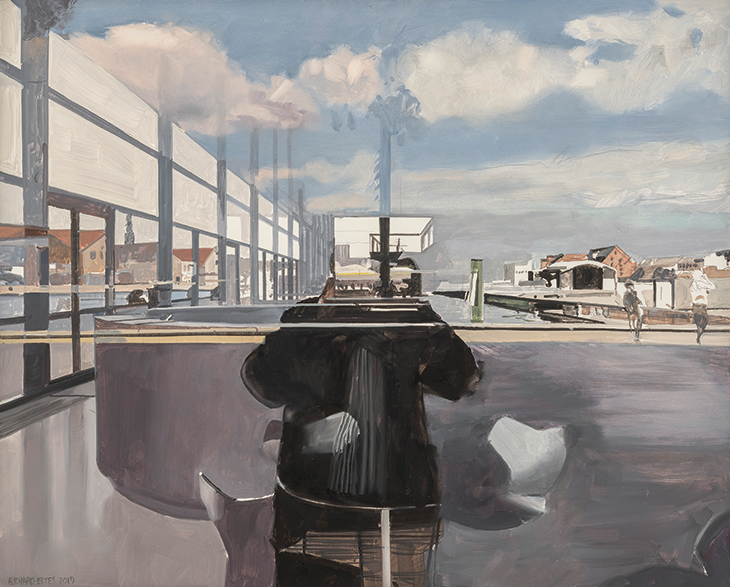
Self Portrait in Copenhagen (2019), Richard Estes. © Richard Estes
Estes is using his camera and photographs as a tool just as so many other artists have over centuries A finished work such as The L Train (2018), with its vertiginous recession and abrupt transition from dark to light, is a translation of camera images into the language of paint. A painting must function as a composition, with the visual rhythms discussed before. It also has to be a coherent space, which means paying great attention to the tonal values.
For Estes, this is crucial. ‘First, I draw on the blank canvas to log all the values, then you can get things to relate one to another. In a way the most difficult thing is not the drawing, it’s the values. Getting the lights light enough to look light, the darks dark, and still keep the detail.’ In a further irony, when the paintings are reproduced in books, magazines and screens, the process is reversed, the works are retranslated. ‘I guess in reproduction people think the paintings look like photographs.’
The training Estes received as a commercial artist also allowed him to find a way past the orthodoxies of the art education of his day, including the traditional omertà about photography. It is clear that artists, including many whom Estes admires, have been using cameras since the 17th century. But formal art education tended to treat this as a shameful secret.
Subsequently, he also discovered a painterly tradition of realism to which he could attach himself. Among the artists from the past he admires are Thomas Eakins and the Venetian vedute specialists Canaletto and Bellotto. His love of the work of Frederic Edwin Church changed his life. ‘I’ve always been a great admirer of Church and the Hudson River School,’ he says, ‘and I guess I wanted to see if I could do something like that. And I now live in Maine where there’s a fabulous landscape which in a way was discovered by painters in the 1850s. They did these paintings of Mount Desert, and people who saw the pictures were persuaded to come up here. It became a watering hole for wealthy collectors from Philadelphia and New York.’
Like Church, Estes has painted not only the landscape of New England, but has also travelled the world in search of the kind of landscapes that used to be called ‘sublime’, indeed he has gone even further than his predecessor did: to the Pacific, New Zealand and remote Antarctica.
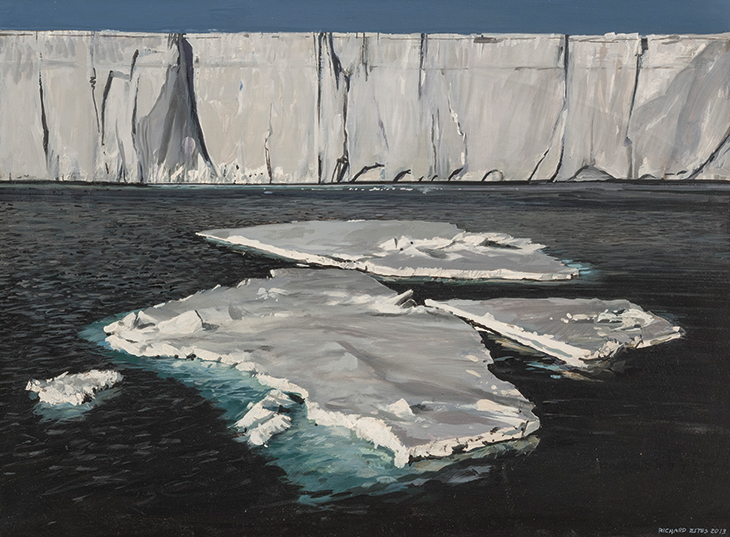
Antarctica I (2013), Richard Estes. © Richard Estes
The tradition he belongs to is not only ‘realist’ but consists of artists who also used the camera as a tool and were concerned with translating its images into the terms of paint. This is true of Eakins, for example, and also of Damien Hirst, who recalls that he has loved Estes’s work since he was shown it by his art teacher at the age of 13. Hirst’s series of works entitled ‘Fact Paintings’, begun in 2000, explore the relationship between painting, photography and truth. All of which explains why his Newport Street Gallery is showing the current exhibition of Estes’s paintings.
Bellotto and Canaletto may have lived before camera images could be chemically fixed (which is what we mean by the invention of photography), but they certainly knew the camera. Canaletto’s own portable camera obscura still survives. Estes is one of those who believes the Venetian made great use of it. ‘I think when you look at some of the paintings of Canaletto, it’s too accurate to have been done just by eye, actually.’ He has even applied his own methods to Canaletto’s subjects. ‘I’ve done a lot of paintings of Venice, and there you can go to places that Canaletto painted and they’re still the same. It’s the one city I can think of where you can actually get a sense of what it was like in the 18th century.’ Even so, Accademia, Venice (1980) depicts not only the Grand Canal and Santa Maria della Salute, but also the looking-glass windows of a vaporetto stop.
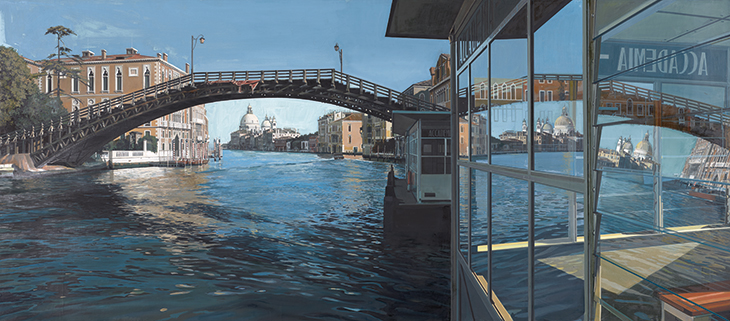
Accademia, Venice (1980), Richard Estes. © Richard Estes
Most of us will agree that Venice is beautiful (perhaps excluding the vaporetto stops), which is not necessarily the case with Estes’s telephone booths, diners, automobiles and office blocks, of which he is wryly aware: ‘Another irony is that I often get the subjects for my pictures out of things that I dislike rather than things that I like. You can think they are ugly, but then in a way they get changed when they become a painting.’ It’s that process of translation, from photograph to painting, from ugly to beautiful, with which Estes’s work is concerned.
From the October 2021 issue of Apollo. Preview and subscribe here.
Unlimited access from just $16 every 3 months
Subscribe to get unlimited and exclusive access to the top art stories, interviews and exhibition reviews.

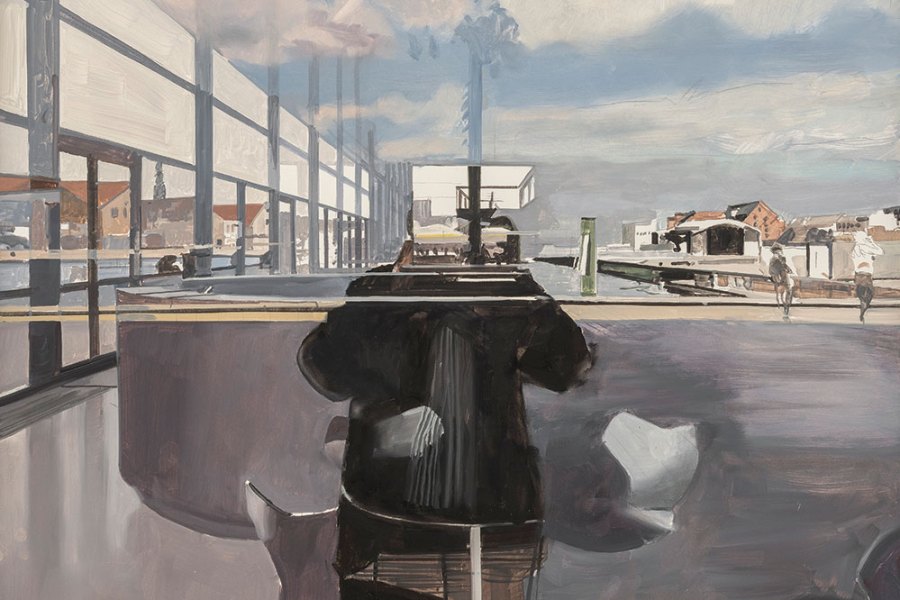
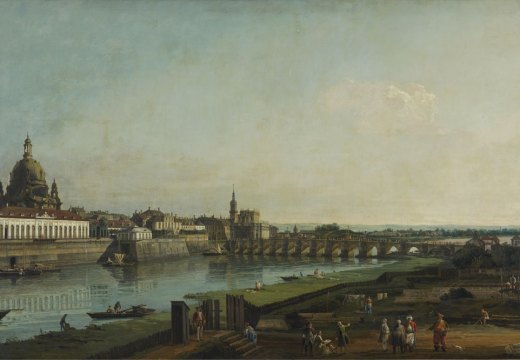
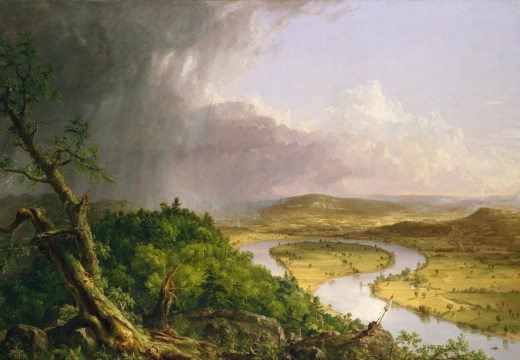
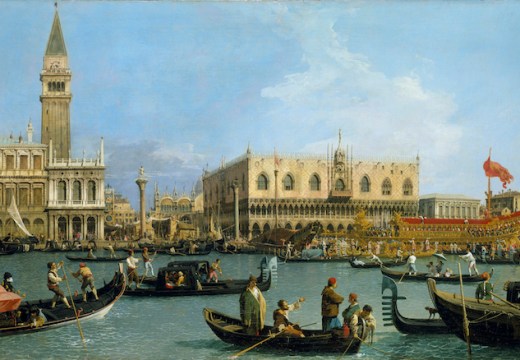


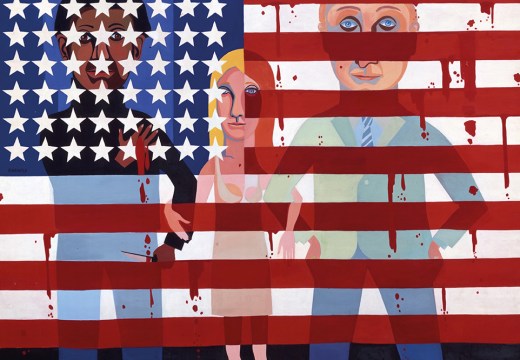





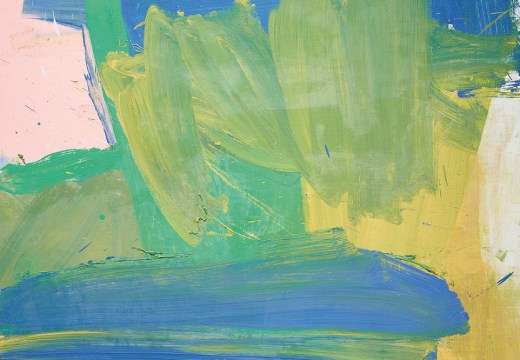
![Masterpiece [Re]discovery 2022. Photo: Ben Fisher Photography, courtesy of Masterpiece London](http://www.apollo-magazine.com/wp-content/uploads/2022/07/MPL2022_4263.jpg)
Why are fathers so absent from art history?